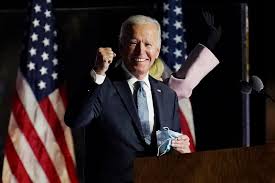As 40 top world leaders gather online for the first big climate confab since 2019, here are the key policies and political dynamics for which to keep an eye out.
By Alexander C. Kaufman | HuffPost
Consider it President Joe Biden’s climate debutante ball.
The White House will convene a two-day summit this Thursday and Friday in which it will unveil its new emissions-cutting goal to world leaders, in a bid to restore America’s reputation in the polite society of global carbon negotiations.
The virtual conference will feature 40 heads of state, including Chinese President Xi Jinping, Indian Prime Minister Narendra Modi and European Commission President Ursula von der Leyen. It is the first major climate gathering since the U.S. rejoined the Paris climate accords, the global carbon-slashing pact former President Donald Trump exited.
“The U.S. is back in the game,” Gina McCarthy, Biden’s domestic climate policy czar, told NPR this week. “They’re not wrong that we have lost some time. But frankly, the U.S. is looking at this as a tremendous opportunity to shift to clean energy. And we would hope that China and our other countries would look at it similarly.”
Countries are expected to present their effects to slash planet-heating pollution and pledge new rounds of financing for poor nations to transition away from fossil fuels.
The Biden administration plans to announce a pledge to cut the U.S. output of climate-changing gases 50% below 2005 levels by 2030, according to reporting in The Washington Post and Bloomberg. The White House declined to comment on the target during a press call Wednesday morning.
But that emissions goal nearly doubles the ambition of what former President Barack Obama pledged when his administration helped broker the Paris Agreement in 2015.
Still, advocates and experts don’t expect much news on substantive policy changes to come out of the summit.
“We’re not seeing a ton of signs that they’re going to make big announcements this week,” said David Turnbull, a spokesman for the climate group Oil Change International.
Most countries will likely save those proposals for when negotiators come to the bargaining table at the United Nations Climate Change Conference in Glasgow, Scotland, this November. The event, delayed since last year because of the COVID-19 pandemic, is where nations will try to reach a deal to increase the ambition of the Paris Agreement.
Yet this week’s summit will offer more than diplomatic pageantry. Here are a few things to watch for:
1. New U.S. Emissions Target
The Obama administration vowed to cut U.S. carbon pollution between 26% and 28% below 2005 levels by 2025, promising “to make best efforts to reduce by 28%.”
Trouble began brewing even before Trump won the 2016 presidential election on a pledge to gut U.S. climate efforts. In February 2016, the conservative majority on the Supreme Court paused the implementation of the Obama-era Environmental Protection Agency’s key regulation to meet that target. Republican state attorneys general sued to block the Clean Power Plan, which aimed to significantly reduce carbon pollution from electricity generators while giving incentives to deploy more solar and wind, arguing its mandates amounted to a “war on coal” that unfairly affected their states. The Supreme Court issued a stay, ordering the EPA to reexamine the regulation’s legal underpinnings.
Once Trump took office, he made Scott Pruitt, the Oklahoma attorney general who led the lawsuits against the Clean Power Plan, the new EPA administrator and set about shredding the rule.
Shortly thereafter, Trump announced the U.S. plan to pull out of the Paris Agreement altogether, making the country’s nationally determined contribution moot.
Ambitious, scientifically sound benchmarks will only go part of the way toward rebuilding trust that the U.S. is seriously committed to weaning its economy off carbon. In a series of conference sessions, top administration officials, including McCarthy, Secretary of the Interior Deb Haaland, and Energy Secretary Jennifer Granholm, will outline the White House’s lofty plans to restrict carbon from power plants and automobiles, research new technologies, and conserve broad swaths of ocean and forests.
To reach the new emissions target, Biden will likely need to enact a clean energy standard that eliminates emissions from 80% of the U.S. power supply by 2030 and 100% by 2035, said Robbie Orvis, the director of energy policy design at Energy Innovation, a climate and energy policy think tank based in San Francisco. Biden has indicated he wants to pursue that route. But Orvis said it won’t be enough.
“A clean energy standard on its own will not squeeze out all the coal by 2030,” he said. “We need some other set of policies, whether it’s regulations on coal, assistance on transitioning from coal, or something to eliminate the remaining coal emissions altogether. If we don’t eliminate coal by 2030, it’s very hard to achieve a 50% reduction. It might be impossible.”
2. Will China And The U.S. Make Nice?
Biden has maintained a hawkish stance toward the world’s second-largest economy. A bilateral summit in Alaska last month boiled over into publicly undiplomatic statements.
The White House has repeatedly framed its domestic climate efforts as a bid to “out compete” China and blunt the political rise of the world’s most populous nation, worrying progressives who note that fear-mongering contributes to the country’s alarming spike in anti-Asian violence and that the U.S. could get locked into an endless cycle of increasingly aggressive competition. The administration’s fact sheet on its $2.3 trillion package to rebuild infrastructure at home last month mentioned China by name five times. Just last week, Secretary of State Antony Blinken reaffirmed the U.S.’s “serious commitment” to Taiwan, which China sees as a breakaway province, and rallied Japan to make aggressive statements about defending the self-governing island territory from Beijing.
Yet, on climate, there has been some progress. Despite the blows in Alaska, the U.S. described the meeting as “substantive” while China called them “candid, constructive and beneficial.” A day after the meeting, China said the two nations would set up a joint working group on climate change.
Last week, White House climate envoy John Kerry went to Shanghai and ended his trip with a formal agreement between the two countries to work together on climate.
Xi’s attendance this week marks another positive sign, though a senior White House official said Wednesday that Biden would not meet privately with his Chinese counterpart.
“We are not having any bilateral or side Zoom room discussions over the course of the next few days,” the official said.
Likewise China Vice Foreign Minister Le Yucheng said in an Associated Press interview that his country would not buck to pressure to up the ante on its pledge to peak its emissions in 2030 and reach carbon neutrality by 2060.
“For a big country with 1.4 billion people, these goals are not easily delivered,” Le said. “Some countries are asking China to achieve the goals earlier. I am afraid this is not very realistic.”
3. What To Make Of Brazil
Brazil’s far-right President Jair Bolsonaro came to power in 2019 promising to industrialize the Amazon, drawing condemnation from across the world. Global concerns went beyond the displacement of hundreds of Indigenous peoples who live in the largest rainforest (though the Bolsonaro administration has drawn accusations of genocide at home). Rather, they came from concern that the lush jungle would lose its status as a net absorber of carbon dioxide emissions, jeopardizing global climate goals.
Bolsonaro vehemently pushed back against such charges. While he found a kindred spirit in Trump, he accused Biden and leaders across Europe of infringing on Brazilian sovereignty. He called them hypocrites, noting that their countries grew wealthy by destroying the old-growth forests that once covered broad swaths of their territory. By last year, Amazon deforestation hit a 12-year high of nearly 4,300 square miles cleared in just 11 months. As a result, a study published in the journal Frontiers in Forests and Global Change last month found that the Amazon may now emit as much carbon as it sequesters.
All that has made Biden itch for some kind of a deal to dissuade Bolsonaro from clearing more forest. The White House is under pressure from Senate Democrats to condition billions in U.S. aid to Brazil on environmental pledges ― and administration officials have made it clear, in the weeks leading up to the summit, that any potential agreement with Brazil is contingent on Bolsonaro making concrete commitments to curb deforestation immediately.
But state governors, Indigenous leaders and environmentalists in Brazil warned Biden against making any kind of deal with Bolsonaro. Talks between the two countries have been ongoing since February.
It’s unlikely that either side would make any big announcements this week. But the leaders’ speeches could offer clues as to how it’s going.
4. Big Money Pledges
Countries aren’t just expected to pledge domestic emissions cuts. They’re likely to put up some money, too.
The Paris Agreement included a $100 billion U.N.-administered Green Climate Fund to help poorer countries pull their people out of poverty with clean energy investments. Nearly six years later, the fund is barely one-tenth of the way to being fully financed.
The U.S. initially pledged $3 billion, but only handed over $1 billion by the time Obama left office. Trump canceled all future payments. This month, Biden asked Congress for $1.2 billion to pay into the fund. That’s still far below the remaining $2 billion Obama promised and would put the U.S. behind, France, Japan and Germany.
Instead of increasing funding to developing countries, rich nations have recently announced more restrictions on what types of projects their public financing arms can support. In December, the United Kingdom vowed to end all public support for overseas fossil fuel projects. Seven European countries followed suit last year.
Such policies threaten to stunt development in poor countries and encourage China to finance more coal plants, said Arvind Ravikumar, an assistant professor of sustainable energy development at the Harrisburg University of Science and Technology.
“The U.S. cannot be the country that only keeps saying no,” he said. “It has to say yes to something. If you’re not going to do it, China is going to come in and do it. So there is a very big role for the Biden administration to be proactive here and support the things they do like.”
A fairer system for dictating fossil fuels’ future in the developing world might look like a “tiered system in which countries with lower per-capita incomes, low emissions or high use of green energy are deemed more eligible for development projects that depend on fossil fuels,” Vijaya Ramachandran, a fellow at the Center for Global Development, wrote in the journal Nature this week.
5. Intellectual Property Fights
We are seeing a version of this play out already with vaccines. Poorer countries struggling to obtain enough vaccines to inoculate their populations against COVID-19 are pleading with rich nations to lift patent restrictions and allow companies to produce generic jabs en masse.
India and South Africa, predicting this would become an issue, started demanding bans on COVID-19 vaccine patents last year. The director-general of the World Health Organization last month urged rich countries like the U.S. and Canada to grant patent waivers.
Yet the biotech industry has insisted that waiving patents would “undermine our response to this pandemic and future health emergencies” by disincentivizing companies’ participation. The influential and conservative U.S. Chamber of Commerce called demands for waivers “misguided.”
A similar dynamic could well play out with green energy. At a moment when the world needs to take unprecedented steps toward transitioning away from fossil fuels, allowing countries like Bangladesh, Colombia and Gabon to freely replicate solar panels and battery breakthroughs researched in the U.S. could be the difference between keeping warming within 1.5 degrees Celsius and facing the catastrophic consequences of failing to do so.
As the U.S. touts fresh efforts to beef up research and development, those demands could well surface from some of the African, Asian and Latin American countries represented at the conference.
Read more related articles >>







